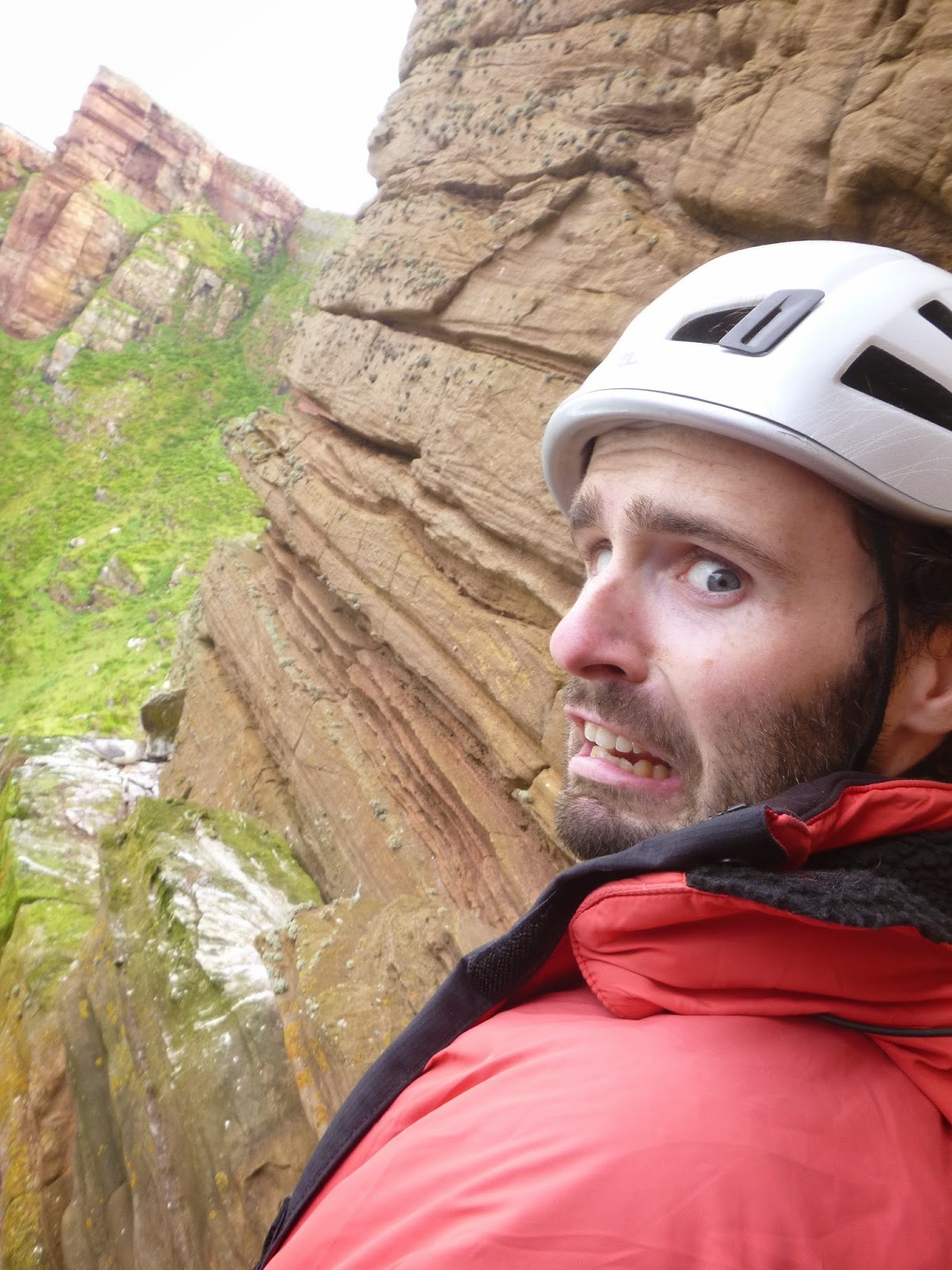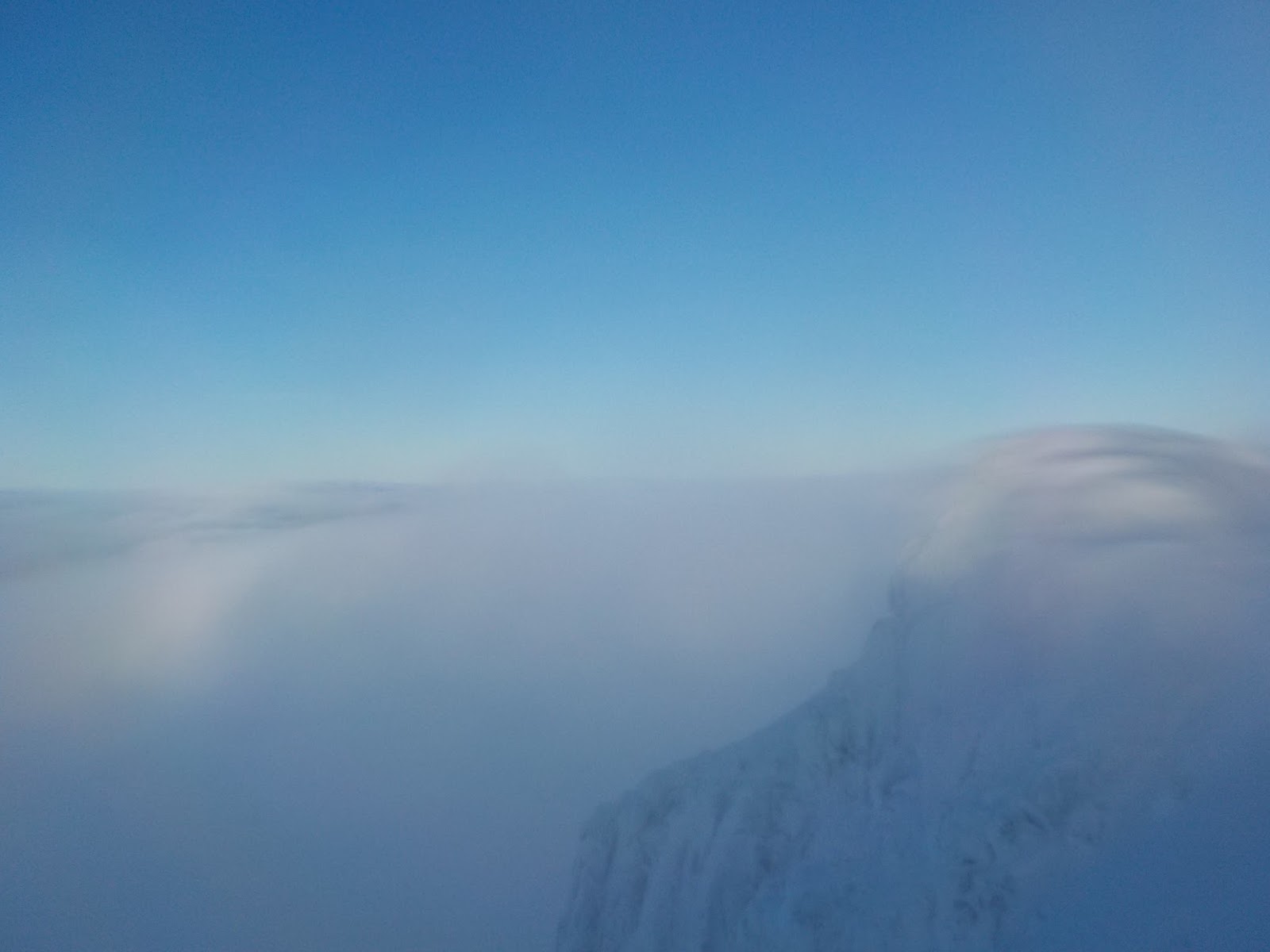I wrote this back in August but totally forgot to post it...
Conor Gilmour is a bad man, or at least I’m particularly bad
at not agreeing to go along with his ideas. So when last week he suggested we
go climb the Old Man of Hoy, I couldn’t refuse, particularly since I already
(somehow) had when he suggested it back in May.
The Old Man of Hoy is a particularly famous sea stack
situated (unsurprisingly) on the island of Hoy. Unfortunately, Hoy is in the
Orkneys, which are rather remote from Belfast. But an adventure is an
adventure.
It is a 135m tall lump of Orcadian sandstone, situated on a
platform jutting out of the western side of the island. Although sturdy
looking, it has only existed for about 200 years – with no references to it
before the turn of the 19th century. It’s changed even since then,
with a substantial portion collapsing in the 1850s or so. It’s unlikely to
stand for much longer, either.
I caught the ferry/bus to Glasgow on Monday 28 July and met
Conor there that evening. Plans were hatched, shopping bought (including
obligatory summit beer) and bikes loaded.
SKOOF, the Gilmourmobile
The plan necessitated a 300 mile
drive to Gill’s Bay in Caithness, whereupon we would catch a ferry to St
Margaret’s Hope on Orkney Mainland (confusing name) and cycle the 30 miles
round Scapa Flow to Stromness. From here another ferry would take us to Hoy,
and a 5 mile cycle across the island would leave us at Rackwick, close(ish) to
the Old Man. Simple.
Unfortunately, the 0700 start from Glasgow was not
sufficient to reach the 1300 ferry in time (largely due to the frustrating
lorries on the A9 road) and we arrived at Gill’s Bay at 1303, just in time to
see the ferry pulling out of the harbour. This frustratingly left us with 6
hours until the next ferry, and we (wisely) decided that we would abandon plans
to cycle round Orkney and would catch the direct ferry from the brilliantly
named port of Scrabster direct to Stromness that evening. In the meantime, we
went to the most northernly point in Britain (Dunnet Head) and saw puffins.
Puffins are great.
There’s 21,000 people in the Orkneys. I was expecting
something like the Aran Islands in Ireland but it’s nothing like that. There is
apparently even a Sports Direct. You know your island is going places when it
has a Sports Direct. The boat over, the Hamnavoe,
was a lot bigger than I was expecting. We got a look at the Old Man on the way.
He looked scary.
The aul' fella from the boat
When we eventually reached Stromness it was way too late to
get to Hoy. Being intelligent we never bothered bringing a tent, and our plan
of sleeping under a bridge was scuppered when it was found to be tidal. So we
coughed up and stayed in a hostel, which was exceptionally pleasant.
Hoyward bound
Tuesday morning we got on to Hoy. The weather was pants. We
spent an hour in the church at Moaness drinking free tea and coffee and reading
about Hoy. When we eventually bit the bullet and cycled to Rackwick on one of
Hoy’s two roads we got soaked. Things didn’t look promising.
Free coffee church
Rackwick is beautiful. It’s a little bay in the southwest of
Hoy, with cliffs and hills on both sides and access along a glen through the
middle of the island between some large hills which have claimed a number of
aircraft over the years. The bothy we stayed in is right at the beach and is a
lovely wee old cottage fully equipped with a toilet and a tap. We shared the
place with a Lithuanian man who was cycling round Scotland but who was quite
difficult to talk to.
Rackwick and the bothy
It didn’t clear up til Wednesday evening so we caught up on
some sleep and listened to the crash of the waves. Thursday however dawned
gloriously, so we got up at the crack of 0930 and set off towards the Old Man.
It’s an hour’s walk from Rackwick to the Old Man, along a
great path. At the headland opposite the stack we paused to have a look at the
bloody thing, which we now resigned ourselves to climbing since we’d come so
far. It’s funny how psyche drains the closer you get to actually doing the
thing you’re supposed to be psyched about. It rises from its platform like an
improbably skyscraper, seemingly overhanging on every side, except for an
open-book corner that starts at mid height. It was first climbed in 1966 and
was made famous by a TV broadcast in 1968. Our route was the original east face
(inland) route, graded E1 5b and supposedly one of the best routes in the
country. We expected great things.
The scramble to the base of the Aul Fella is described as
‘trouser filling’ which is about right. This is probably the most dangerous
part of the whole affair. Once safely down, Conor took the first lead. This was
a lovely (if sandy) 4b pitch leading up the arête; Conor went first as he hadn’t
done any trad climbing in months and this was supposed to be the easier pitch.
This left me with the crux second pitch.
1st belay
looking up the crux
setting off on the crux
Conor following the crux
This pitch (rightly) has a bit of a reputation. It starts
with an airy downclimb on the east face to a traverse, which in turn leads into
a chimney. None of this can be protected as it will lead to sever rope drag
later. The chimney starts off straightforward but before long leads into a
sentrybox, the exiting of which involves thrutching outwards and up into a fist
sized corner crack. It’s hard to describe the combination of
chimneying/offwidthing/jamming/arête hugging involved in this. Once out of the
sentrybox, straightforward climbing leads to a good belay, where you collapse
and pant for a bit. Conor impressively managed it on second with a rucksack on.
We ended up splitting what is supposed to be pitch 3 into
three smaller pitches due to rope drag and the profusion of amply-provisioned
belay ledges. From here to the top, the climbing was easier but the ledges were
colonised by Fulmars. Fulmars are evil gull things that vomit at you when you
go near them. The whole stack smells a bit like a pet shop because of them.
FULMARS
Throwing shapes
I don't like Fulmars (rightly, it turned out)
The last of these subsidiary
pitches I led. I (almost as an afterthought) clipped an ancient bit of stuck
gear just above the belay and made the easy moves up to a ledge. From here, I
reached up to the next ledge and pulled up, only for a baby Fulmar to appear
right in front of my face and squawk. Instinctively I flinched and before I
knew it I’d lost balance and was flying through the air; I saw Conor flying
past at the belay before I came to a halt below him, smashing into a ledge
ankle- and ass-first. I climbed back up to the belay and Conor asked if I was
OK – adrenaline prevented me from knowing but after a minute or two I came to
the conclusion that I had a slightly sore ankle and a badly bruised arse. But I
was OK. I’d been fortunate – the old gear had held and my 7m or so fall didn’t
come directly onto the belay. I’d managed a Factor 1.5 or so fall, which is
quite a lot. In any case, I got back on and finished the pitch, shaking a bit,
and trying to sneak past the bird that had caused my fall.
The final pitch
The last pitch was an amazing steep open-book corner,
described as ‘an Orcadian version of Cenotaph Corner but not nearly so hard’.
Indeed, holds keep appearing as you climb up it, and it’s never harder than HS,
even if it does look E2 from below. A brief flurry of rain didn’t stop us
topping out and donning the plastic Viking helmet which for some reason resides
there. A celebratory beer was had and we abseiled off, with the ropes only
getting stuck once (which Conor managed to free with some lateral thinking). The Fulmar that had caused my fall proceeded to vomit on my trousers as I abseiled. I really hate that bird.
Summit
Airy abseil
The last abseil (from the top of the second pitch) was free
hanging and almost 60m. I don’t really enjoy abseiling but this was amazing,
hanging in space between the Old Man and the sea and spinning in the breeze.
Unfortunately landing in the ground meant I now had to walk, something my ankle
didn’t enjoy, but my sprained ankle managed the hobble up the ‘trouser filling’
scramble OK and we celebrated survival of another daft adventure with another
beer on the headland opposite the Old Man. Back to the Rackwick bothy and an
early start the next day to cycle, ferry, ferry, cycle, drive home. 12 hours
later we were back in Glasgow, and the next day a further train, bus, ferry,
bus, drive and a lot of hobbling later I was back in Belfast.
19 hours of travelling (each way) is a long way to go for 4
hours of climbing but it was well worth the effort, even just to see the
Orkneys, which are brilliant. Scapa flow is full of German warships which are
apparently great for divers. The whole archipelago is more like Norway than Scotland.
Just getting to the
Old Man of Hoy is an adventure in itself, and the route itself is brilliant,
like a mix of gritstone and Fair Head. Go do it, before it falls over, and mind
the fecking Fulmars.
Push your limit, mind your ankle.
See this link for information on funny placenames in the
Orkneys.







































